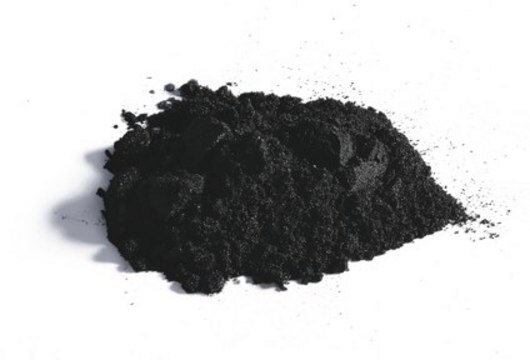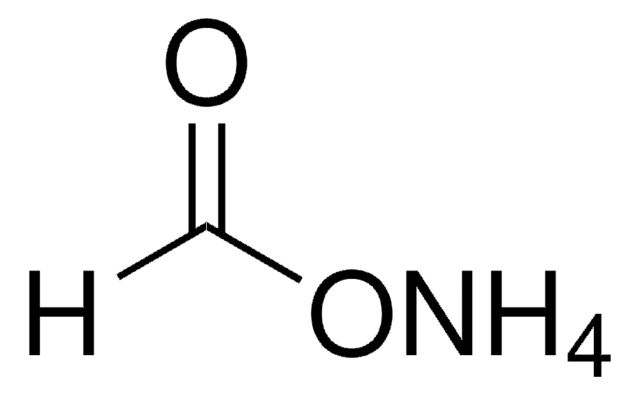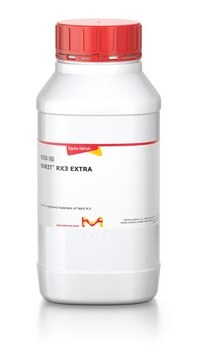1.02005
Charcoal activated
for the determination of AOX (shaking method)
Sinónimos:
Charcoal activated
Iniciar sesiónpara Ver la Fijación de precios por contrato y de la organización
About This Item
Fórmula empírica (notación de Hill):
C
Número de CAS:
Peso molecular:
12.01
Número MDL:
Código UNSPSC:
11101522
Número índice de la CE:
231-153-3
NACRES:
SE.11
Productos recomendados
Nivel de calidad
Formulario
solid
técnicas
photometry: suitable
mp
3550 °C
densidad aparente
150‑440 kg/m3
temp. de almacenamiento
2-30°C
cadena SMILES
[C]
InChI
1S/C
Clave InChI
OKTJSMMVPCPJKN-UHFFFAOYSA-N
Aplicación
- Adsorptive Removal of Dyes and Contaminants: Activated charcoal is extensively used for the adsorption and removal of dyes and other contaminants from aqueous solutions. Recent research highlights the use of activated charcoal modified with BaFe12O19 powder for the efficient removal of methyl blue dye. This magnetic adsorbent can be easily retrieved and reused, making it a sustainable option for water purification (Polley and Bera, International Journal of Environmental Analytical Chemistry, 2023).
- Heavy Metal Detection and Removal: Activated charcoal is utilized in composite materials for detecting and removing heavy metals from water. A notable study developed a Ni-sensor based on activated charcoal plastic membranes, showcasing the material′s effectiveness in analytical applications for environmental monitoring and pollution control (Zareh et al., Journal of Analytical Chemistry, 2022).
- Filter Composites for Industrial Wastewater Treatment: Activated charcoal combined with banana rachis cellulose nanocrystals has been used to create filter composites for industrial wastewater treatment. These composites effectively remove dyes and heavy metals, demonstrating their potential for large-scale environmental applications and enhancing water quality (Rahman et al., International Journal of Environmental Analytical Chemistry, 2022).
- Dental Applications: In dental research, activated charcoal combined with calcium hydroxide has been evaluated for its effect on dentin microhardness. This combination shows promise in dental treatments, particularly in enhancing the mechanical properties of dentin and offering potential benefits in restorative dentistry (Abdel Hamid, Egyptian Dental Journal, 2023).
- Environmental Adsorbents and Sensors: Activated charcoal is also used in creating advanced environmental adsorbents and sensors. For instance, a study focused on the development of magnetically retrievable BaFe12O19-activated charcoal-chitosan composite powders for the adsorption of methyl blue dye. These materials offer high efficiency, reusability, and easy recovery, making them ideal for environmental remediation applications (Polley and Bera, International Journal of Environmental Analytical Chemistry, 2022).
Nota de análisis
Iodine number: ≥ 1050 mg/g
Chloride (Cl): ≤ 0.0015 %
Particle size (< 150 µm): ≥ 70
Specific surface area (BET): about 850
Chloride (Cl): ≤ 0.0015 %
Particle size (< 150 µm): ≥ 70
Specific surface area (BET): about 850
Código de clase de almacenamiento
11 - Combustible Solids
Clase de riesgo para el agua (WGK)
nwg
Punto de inflamabilidad (°F)
Not applicable
Punto de inflamabilidad (°C)
Not applicable
Certificados de análisis (COA)
Busque Certificados de análisis (COA) introduciendo el número de lote del producto. Los números de lote se encuentran en la etiqueta del producto después de las palabras «Lot» o «Batch»
¿Ya tiene este producto?
Encuentre la documentación para los productos que ha comprado recientemente en la Biblioteca de documentos.
Nuestro equipo de científicos tiene experiencia en todas las áreas de investigación: Ciencias de la vida, Ciencia de los materiales, Síntesis química, Cromatografía, Analítica y muchas otras.
Póngase en contacto con el Servicio técnico




